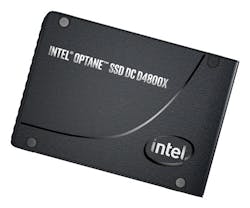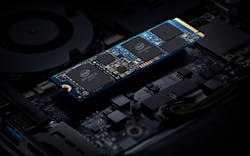Whether server solutions or embedded applications on the edge, Intel has been pushing its non-volatile Optane technology across the board. Optane is now available in multiple form factors, including DIMMs that support persistent-memory programming, dual-port NVMe SSDs, and everything in between.
The Intel Optane DC U.2 D4800X SSD (Fig. 1) targets mission-critical applications on servers and cloud farms. Its dual-port, NVMe interface provides high-speed access to its non-volatile storage. The SSD is 9X faster than a dual-port NAND-based solution that’s under write pressure. The family comes in a 750-GB version with a PCI Express (PCIe) 3.0 x4 interface. A PCIe card form factor is available as well.
1. Intel’s D4800X is a dual-port SSD designed for mission-critical environments.
The DIMM-based solution (Fig. 2) provides persistent-memory support. The Optane DC Persistent Memory module is available in capacities of 128, 256, and 512 GB. The module is pin-compatible with DRAM, although the motherboard BIOS may need to be updated to handle configuration. It’s designed to work with Intel’s latest Xeon processors. The DIMMs are supported by the open-source Persistent Memory Toolkit.
2. The DIMM-based Optane solution offers persistent-memory support.
The M.2 H10 memory module (Fig. 3) takes a slightly different approach by combining two non-volatile memory technologies: flash memory and Intel Optane DC memory. It mixes the high capacity and low price of quad-level-cell (QLC) 3D NAND technology with the higher performance of Optane DC storage.
3. Intel’s latest M.2 H10 memory module combines QLC flash with Optane storage.
The H10 is available in 16-GB/256-GB Optane/flash memory, 32-GB/512-GB and 32-GB/1-TB configurations. The 80-mm module will work in any system that can support M.2 flash storage. They all have a x4 PCIe 3.0 interface.
Optane DC memory isn’t needed for all applications, but many can benefit from its durability and performance. It provides higher performance than NAND flash while providing non-volatile storage capabilities. These days, it’s not unusual to have a tiered memory structure with on-chip SRAM cache, DRAM, Optane DC, and flash storage.





